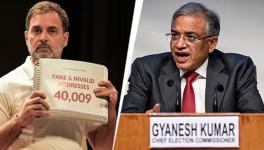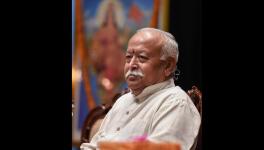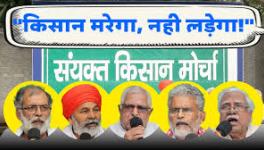Is Ram Mandir a Mere Election Strategy of the BJP?

As the country approaches 2019 Lok Sabha elections, the issue of the Ram Janambhoomi movement and Ram Mandir have resurfaced. Farmers, dalits, minorities, workers, peasants, students, teachers, tribals and various sections of the society are taking to the street protesting against the regressive policies and failure of the current Narendra Modi-led Bharatiya Janata Party (BJP) government in the centre. This government which has failed to achieve the “development” goal, based on which it came to power is also being criticised for the growing intolerance and hatred in the country. Mohan Bhagwat, Rashtriya Swayamsevak Sangh (RSS) and its affiliates do not consider these demands of the people important. Ram lalla and his majestic temple is what they are interested in. The symbol of communal violence in the country- the demand for building a Ram Temple in the place of Babri Mosque which was demolished by the RSS, BJP, Vishwa Hindu Parishad (VHP) and their affiliates on December 6, 1992- is being invoked by the RSS yet again.
This shows that nothing has changed in the approach of the RSS-.BJP. Communal polarisation has been and continues to be the strategy of the ruling party and its ideological parent. On January 28, 2016, Bhagwat in Pune made this clear by saying that building the ‘mandir’ is the top most priority of the government. A student in a gathering of students in the 6th Conference of Indian Students organised by the MIT School of Government asked Bhagwat a question that most of us have for him and the current BJP government; he asked, “Will the poor in the country be fed by building Ram Mandir?” For which the Sarsanghchalak had replied, “The mandir has not been built, so are the poor in the country being fed now? It is not the question of building a temple but of dedicating a memorial for an icon, the Adarsh Purush (ideal man) in his birthplace.” This has always been the way of the Hindutva organisation and its political arm BJP- to not answer the posed question. In short, with or without the temple, the poor in the country will not be fed was Bhagwat’s reply.
United by Bharat Mata?
The demand for building a Ram Mandir in the place of Babri Masjid is not new, originating in 1855, before the struggle of 1857. Ram Lalla’s idols were placed in the mosque on December 22, 1855, which later would become a tool for the Sangh Parivar (SP) to provoke sentiments of the dominant Hindu majority to accomplish their goal of Hindu Rashtra. The imagery of a nation of Hindus for the Sangh could be achieved only through washing away the religious-cultural pluralism in the country. In the first ‘Dharma Sansad’ (Religious Parliament) of Vishwa Hindu Parishad (VHP) in 1984, a resolution was unanimously adopted demanding the ‘liberation’ of the site of birth of Ram. Sri Ram Janambhumi Mukti Yagna Samiti (Committee of sacrifice to Liberate Ram’s Birth Place) was founded under the leadership of Mahant Avaidyanath (July 27, 1984). As Christophe Jaffrelot writes, “It’s (Ram Janmabhoomi movement) impact derived once again, from the diversity of sects represented in it since ‘Vishnuites, Shaivites and Tantrists’ who have a long history of violent competition were peacefully gathered under the banner of a goddess not worshipped by any of them; Bharat Mata, Mother India.”
Is it an election strategy of the party?
It is not merely a strategy for winning the elections. The BJP-RSS is well aware that they cannot win elections based on building the temple. The BJP which took over the religion based politics of the Sangh Parivar in a big way, lost the elections consequent to the Babri Masjid demolition. This was probably because, as Ram Puniyani writes, it was only those belonging to the SP who referred to the demolishing of the mosque as wiping away the blot on the face of the nation and were celebrating the event as Shourya Divas (day of Bravery), Hindu Navnirman Divas (day Hindu resurgence) etc. However, it was a day of shame for the secular and democratic values for a large section of the society. For them, this was a major onslaught on the principles enshrined in the Indian constitution.
However, as Asghar Ali Engineer observed, “There is no doubt that the BJP was a great political beneficiary of this controversy. It went on increasing its seats in the parliament thanks to the Ram Mandir controversy and through strategic alliances in elections. It had increased its strength from two to 88 seats in Parliament in 1989 elections itself, with the help of this controversy and through alliance with V. P. Singh's Janata Dal and other secular parties. In the 1991 elections, this controversy was at its height and the BJP further increased its strength from 89 to 114.”
Permanent Damage to the Secular Fabric
Even though the BJP could not gain votes through the communal politics, SP and the BJP were successful in dividing the society by causing a permanent damage to the secular fabric of the country. This was and is the sole aim of the Hindu right wing in the country- communally polarising the country by generating the sentiment of hatred in the Hindu majority against the minority. The image of a Hindu mythological hero- Ram was the best way this could be achieved. Mohan Bhagwat, the Sarsanghchalak of the RSS recently was seen attempting to redefine the Hindutva agenda and Hindu Rashtra of the Sangh Parivar. On the last day of this ‘outreach’ programme he was reported to have said, “Ram is Bhagwan (god) for many, but there are some who consider him as an icon of maryada (moral standard), for some he is imam-e-hind (spiritual leader). This is an issue of faith for all sections of society that where his birthplace is, there should be a temple.”
The demolition of Babri Masjid was followed by an outburst of communal violence throughout India particularly in Bombay, Ahmedabad, Surat, Calcutta, Kanpur, Malegaon, Bhopal, Delhi and several other places, in which hundreds of people lost their lives. Engineer notes that the whole decade of eighties and early nineties was a period of great communal crisis. He writes, “As it is well-known, the Ram Mandir controversy was a purely political one; it was neither religious nor even historical in nature. Most eminent historians belonging to secular schools of thought maintained firmly that there is absolutely no historical or archaeological proof for existence of any temple at the site of the Babri mosque. When confronted with the historical and archaeological arguments, the SP leaders changed the line of arguments and started saying that it is not a historical matter alone, it is basically a matter of faith for the Hindus.”
Also read: History and Nature of the Ayodhya Dispute
When unemployment, poverty, malnutrition, communal violence and atrocities are gripping the country, the Sangh Parivar by using Ram Mandir as a tool is trying its level best to divert the attention of the country to what it calls faith. Speaking at a function held at Patanjali Yogpeeth on October 1, 2018, Bhagwat said the RSS and the BJP is committed to constructing a Ram temple in Ayodhya but certain things take time. The chief of the Sangh is reported to have said, “Every government has its limitations and it has to perform within those constraints. However, saints and seers are beyond such limitations and they should work for the uplift of religion, country and society.”
The case pertaining to the construction of a temple at the disputed spot is currently being heard in the Supreme Court, while the Vishwa Hindu Parishad, an RSS affiliate and one of the main campaigners for the temple has been demanding that the government should consider bringing an ordinance if a solution is not found through the legal route.
Get the latest reports & analysis with people's perspective on Protests, movements & deep analytical videos, discussions of the current affairs in your Telegram app. Subscribe to NewsClick's Telegram channel & get Real-Time updates on stories, as they get published on our website.
























